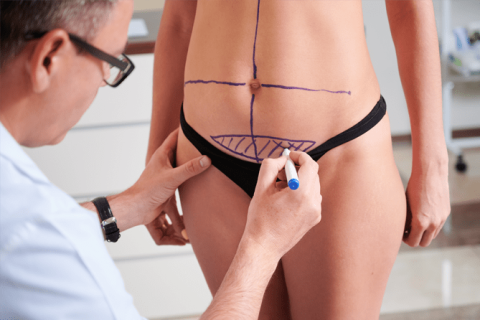Liposuction isn’t just about removing fat – it’s a surgical technique specifically designed to target stubborn deposits that resist diet and exercise. While not a weight loss solution, it can effectively sculpt and contour your body in desired areas.
Unveiling the Nuances of Liposuction: Beyond Superficial Sculpting
While liposuction is often associated with aesthetic reshaping, its applications delve deeper than mere body sculpting. Here’s a glimpse into the unique aspects of this transformative procedure, presented in a formal tone:
- A Symphony of Techniques: Liposuction is not a monolithic procedure; it encompasses a diverse orchestra of techniques:
- Tumescent Liposuction: This prevalent method involves infiltration of saline and local anesthetic solution to tumesce (swell) the tissue, facilitating easier fat removal and minimizing blood loss.
- Superficial Liposuction: This technique targets superficial fat deposits, ideal for areas like the chin, upper arms, and knees.
- Deep Liposuction: Addressing deeper fat layers, this method requires greater precision and is employed for areas like the abdomen, thighs, and buttocks.
- Power-Assisted Liposuction: Utilizing oscillating cannulas, this technique aids in breaking down and aspirating fat, reducing manual effort and potentially shortening procedure time.
- VASER Liposuction: This utilizes ultrasound energy to liquefy fat cells for easier removal, potentially minimizing bruising and discomfort.
- Beyond Aesthetics: Therapeutic Applications: Liposuction transcends its image as purely aesthetic. It plays a crucial role in:
- Lymphedema Management: Liposuction can alleviate debilitating lymphedema, a chronic condition causing fluid accumulation in limbs.
- Lipodystrophy Correction: This procedure can address lipodystrophy, a fat distribution disorder resulting in localized fat loss, by restoring balance and symmetry.
- Gynecomastia Treatment: Liposuction effectively removes excess breast tissue in men suffering from gynecomastia.
- A Collaborative Approach: A successful liposuction journey requires collaborative efforts:
- Preoperative Consultation: In-depth discussion with a qualified plastic surgeon is crucial to determine candidacy, address concerns, and establish realistic expectations.
- Patient Selection: Preoperative medical evaluation ensures patients are fit for surgery and minimizes potential risks.
- Postoperative Care: Following surgeon instructions regarding compression garments, activity limitations, and wound care is essential for optimal healing and successful outcomes.
- Research and Innovation: The landscape of liposuction is constantly evolving:
- Fat Grafting: Liposuction-derived fat can be reinjected into other areas for contouring and volume enhancement.
- Minimally Invasive Techniques: Developments in cannula design and suction technology strive to minimize incisions and scarring.
- Personalized Medicine: Advancements in genomics and 3D imaging are shaping the future of liposuction, allowing for tailored procedures based on individual anatomy and fat distribution.
In conclusion, liposuction is a multifaceted procedure with applications extending beyond the realm of aesthetics. Understanding its diverse techniques, therapeutic potential, and the importance of collaboration empowers patients to make informed decisions and embark on a successful journey towards body reshaping or addressing specific medical conditions.
How is Liposuction Performed?
Liposuction targets stubborn fat deposits through minimally invasive suction techniques. Here’s how it typically unfolds:
- Anesthesia: Local anesthesia numbs the treatment area, providing comfort during the procedure. General anesthesia is an option, but recovery times may be longer.
- Fat Removal: The surgeon inserts a thin, hollow tube (cannula) through small incisions. Using gentle suction, the cannula loosens and extracts fat cells, thinning the fat layer beneath the skin.
- Recovery and Observation: Following the procedure, you’ll be monitored for several hours before returning home. Expect minor swelling and bruising for several days. Wearing a compression garment to support the treated area is often recommended.
- Gradual Improvement: Rest for a few days, gradually increasing activity as you feel comfortable. Full recovery can take several weeks.
- Areas and Timing: Liposuction can be applied to one or multiple areas, depending on your goals. The procedure duration varies based on the treated areas and amount of fat removed.
- Long-Term Maintenance: Liposuction aims to smooth and reshape your body. Remember, consistent healthy habits like diet and exercise are crucial for maintaining your desired results.
Drilling Down the Differences: Laser Liposuction vs. Traditional Liposuction
Both procedures tackle unwanted fat, but their approaches diverge significantly. Here’s a breakdown:
Laser Liposuction:
- Fat removal with finesse: Utilizes laser energy to liquefy fat cells, making them easier to extract. Think gentle melting, not aggressive suction.
- Minimally invasive: Smaller incisions and less tissue manipulation lead to potential for faster recovery and reduced pain.
- Double duty: Some techniques combine fat removal with collagen stimulation, promoting smoother, tighter skin.
Traditional Liposuction:
- Direct extraction: Employs a cannula (vacuum tube) to mechanically suction fat cells out of the body. Can be more aggressive and require larger incisions.
- Potentially longer recovery: May involve more bruising and discomfort due to tissue manipulation.
- Focused on fat removal: Primarily targets fat removal, with limited impact on skin tightening.
Here’s the key difference:
- Laser liposuction: Melting and removal.
- Traditional liposuction: Suction and removal.
Beyond the technique:
- Lipolysis: A separate fat reduction technique using laser energy to shrink and tighten fat cells without complete removal. Consider it fat sculpting, not full-blown removal.
Choosing the right approach:
Consult a qualified healthcare professional to discuss your goals and understand which technique best suits your needs and body composition. Consider factors like:
- Desired outcome: Smoother skin, fat removal, or both?
- Pain tolerance: Preference for minimally invasive options?
- Recovery time: Willingness to commit to potentially longer healing?
Considerations After Liposuction
Following liposuction, careful attention to recovery factors plays a crucial role in minimizing discomfort and optimizing results. While individual experiences vary, these general guidelines can be helpful:
- Compression Garments: Wearing a compression garment, as prescribed by your doctor, helps reduce swelling and support tissues during healing. This can improve comfort and promote faster resolution of swelling.
- Rest and Activity: Adequate rest is vital for recovery. Avoid strenuous activity, but gradually incorporate gentle movement like walking or light yoga as approved by your doctor. Pushing too hard can hinder healing and increase risk of complications.
- Medication: Follow your doctor’s instructions regarding prescribed medications. These might include pain relievers and antibiotics to manage discomfort and prevent infection. Consistent use as directed is crucial.
- Hydration: Staying hydrated is essential for overall recovery. Drinking plenty of water helps reduce swelling and supports efficient healing. Remember, adequate water intake also benefits your general health and well-being.
- Gradual Movement: Begin with simple movements and gradually increase activity as cleared by your doctor. This promotes circulation and facilitates healing, but rushing back to intense activities can be counterproductive.
- Nutrition: A healthy diet rich in fruits, vegetables, and lean protein provides essential nutrients for healing and tissue repair. It also helps maintain weight and supports the longevity of your liposuction results.


